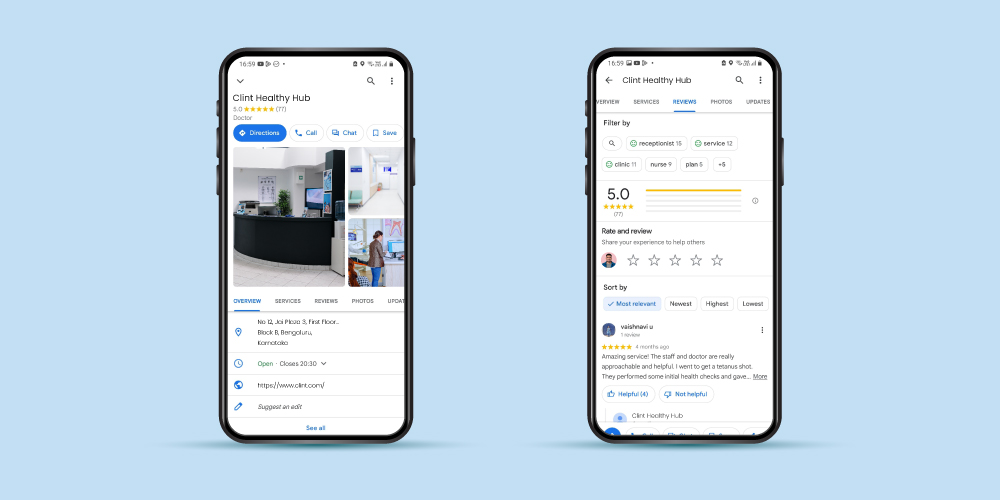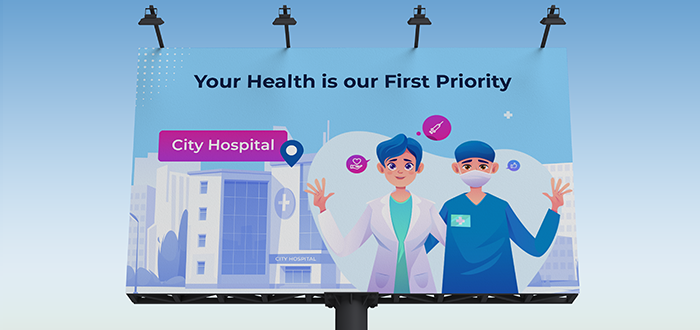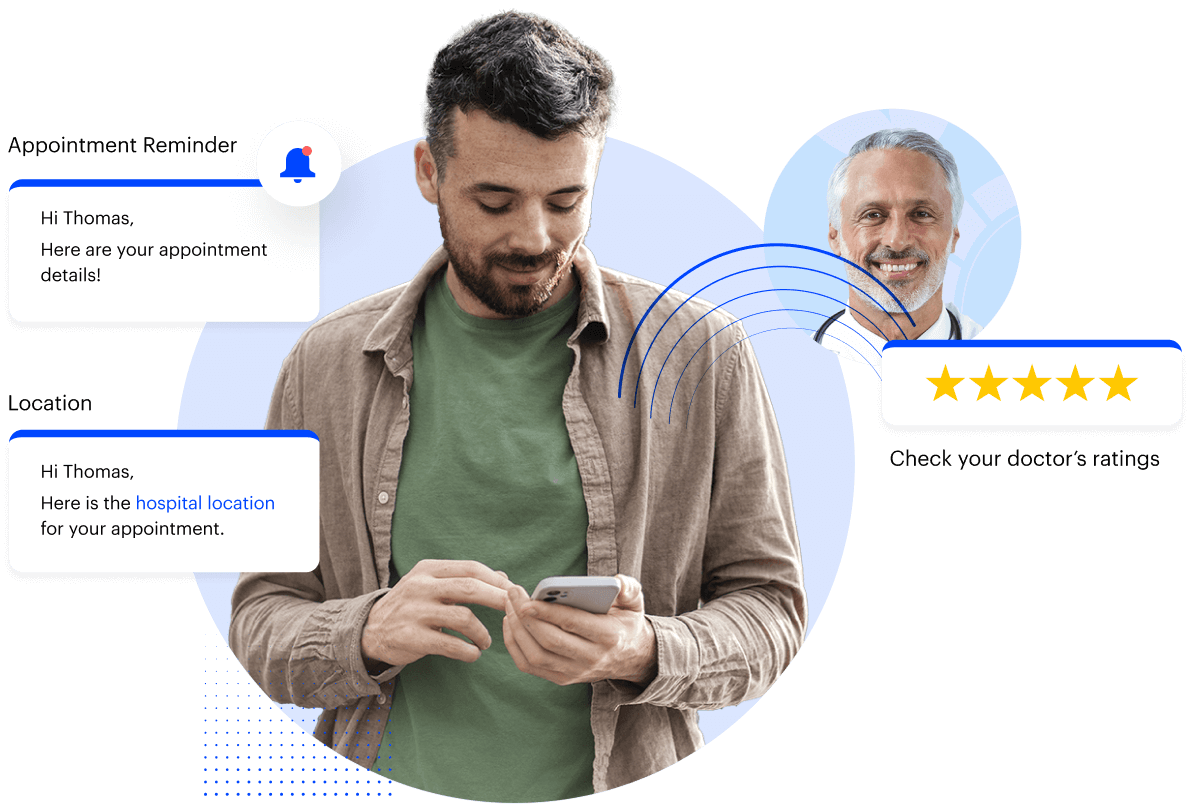- Home
- Learn
- Healthcare
- How to Plan Your Patient Acquisition Strategy for 2025
HEALTHCARE
How to Plan Your Patient Acquisition Strategy for 2025
Contents

Learn about the common challenges and how to build an effective patient acquisition strategy for your clinic or hospital.

Every practice wants more patients. But not every practice has a proper strategy for patient acquisition.
Patient acquisition doesn’t happen on its own just because you deliver quality care.
Today, patients behave more like consumers. They research, compare, and weigh their options before booking an appointment.
This shift means healthcare providers can’t rely on quality care alone to build a stellar reputation. To win patients’ trust, your practice needs to be visible in the right places, communicate clearly, and make it easy for them to take action.
Because if your practice isn’t intentional about building its brand and establishing trust, patients will turn to providers who are. Again, reputation today isn’t just earned through word-of-mouth – it’s built through every online search, review, and interaction a patient has with your brand.
In this article, we’ll walk you through the steps to build a patient acquisition strategy that actually works—covering proven approaches and practical tips. Along the way, you’ll also see how the right tools can help take your efforts even further.
Let’s get into it.
Understanding what your patients truly want goes beyond guesswork and past (anecdotal) experiences. It starts with reliable data.
Begin by exploring what prospective patients in your area are actively searching for. Tools like Google Keyword Planner or SEMrush can help you uncover high-value, relevant search terms. Pediatric care, telemedicine, specialty procedures… what are they in need of? These tools will let you know.
Also, don’t overlook new players like AI chatbots and voice assistants. If you have your own AI chatbot on your site, it’s a great way to engage visitors and learn from the questions they’re asking. And for understanding voice search trends, platforms like AnswerThePublic can help you discover the kinds of questions people are asking aloud.
Next, turn the insights you’ve acquired into patient profiles—mini biographies of your ideal new patients. These personas help you tailor your messaging and services to address their specific concerns.
Once you have laid this groundwork, it’s time to focus on your marketing efforts. This is where you invest strategically to attract and engage the right patients.
Gather the information you need, such as patient demographics, behaviors, and needs. This helps you craft messaging that speaks directly to the people you’re trying to reach.
Use data to guide your outreach. Personalize your website and run targeted ads where your audience is most active.
Track what’s working through website analytics, booking trends, and feedback. Use that information to make smarter, ongoing improvements.
If patients can’t find you online, they can’t choose you.
Many healthcare organizations still operate with incomplete or outdated online profiles. Some may not even have one at all. So, when potential patients go looking for basic information — like what specialties you offer, how well-rated your services are, or whether you accept their insurance — they’re left guessing.
This uncertainty pushes them to keep looking, often toward another provider who’s easier to understand and trust from the outset.
So, don’t miss out on one of the most fundamental and easiest visibility opportunities.
1. Create a Google Business profile
74% of adults aged 40 and older turn to Google for health information. That’s a huge pool of potential patients searching for care. A strong online presence helps them find you easily.
It starts with the basics: create a complete and accurate Google Business Profile. A healthcare Google Business Profile offers a quick look at the information the searcher may want to know about your practice. This also helps you show up in local searches, maps, and even voice queries.
You can go through this article for steps to create a Google business profile.

You can go through this article for steps to create a Google business profile.
The next step would be to create an informational and user-friendly website that acts as your digital front door. Clearly outline your services, highlight your areas of expertise and provide various methods to contact you or book an appointment.
For example, adding a simple appointment booking feature on your website can serve as a powerful tool for converting visitors into new patients.
Here are a few tools you can use to build your medical website as a part of your patient acquisition strategy:
Listing your organization on third-party platforms is a smart patient acquisition strategy.
By creating profiles on healthcare directories, review sites, and online platforms, you can increase your visibility to potential patients searching for providers in their area.
These platforms offer a convenient way for patients to find and evaluate healthcare options, making it easier to discover and connect with your organization.
Here are a few platforms where you can list your healthcare services:
Most patients begin their search for healthcare services online. That makes local SEO one of the most important tools for patient acquisition. When your website is optimized correctly, it helps your practice show up at the top of search results, right when people are looking for care.
But this isn’t a quick win. SEO is a long game, and it takes consistency and patience to see results.
Here are a few fundamental points to include in your SEO strategy:
While SEO can take months to show results, Search (or PPC (pay-per-click)) advertising can generate new patient inquiries almost immediately.
With PPC, you can run targeted ads that appear when people search for healthcare services like yours. This allows you to reach the right audience based on location, demographics, and specific health-related interests—bringing in more patients quickly while your SEO strategy builds momentum.
When used intentionally, social media can be a powerful channel for attracting new patient inquiries—both organically and through paid campaigns.
People now turn to platforms like Facebook and Instagram not just to connect, but to seek out health-related information and guidance as well. You can build credibility and trust with prospective patients by sharing helpful, relevant content — like blogs, videos, reels and infographics. Over time, this also supports your SEO by driving engagement and traffic to your site.
While keeping your Google Business Profile up to date is essential, patients are also discovering providers through voice assistants (like Siri or Alexa), health directories (like Zocdoc, Healthgrades, and Practo), and even AI tools like ChatGPT. These platforms often pull from multiple public sources—so consistency matters. Make sure your details are accurate across your website, directories, and review sites to increase your chances of showing up wherever patients are searching.
Digital tools can enhance the entire patient acquisition process. Compared to traditional marketing, they offer more precise targeting and better control over your budget.
With the right tools, you can identify and reach high-intent patients across channels like search engines (Google, Bing and others), social media, and WhatsApp. Targeted outreach means reduced wastage of resources and better ROI.
Some of these tools also come with powerful tracking features. They let you know which campaigns are working, and which you can improve or discard.
For example: some healthcare CRMs, like LeadSquared, integrate with your outreach campaigns, analytics, and appointment scheduling systems – making digital acquisition a strategic engine for scalable, cost-effective growth.
Harnessing data effectively with these digital tools can help your patient acquisition strategy tremendously.
Here’s how to put that data to work:
Start by understanding who your prospective patients are and what they’re looking for—whether by analyzing which services get the most clicks, where your inquiries originate, or what platforms drive the most engagement.
With a solution like LeadSquared Healthcare CRM, you can unify data from your website, WhatsApp, calls, social media ads, and even EHRs to gain a 360° view of each patient’s journey. This makes it easier to uncover trends and prioritize high-impact opportunities.
Once you know what resonates with your audience, use those insights to tailor your messaging. Segment your audience by interest, condition, or preferred channel, and deliver personalized experiences—like automated WhatsApp reminders, geo-targeted Google Ads, or timely email campaigns.
LeadSquared helps you activate these insights by streamlining outreach across all integrated channels, ensuring every patient touchpoint is relevant and timely.
Patient needs evolve—and your strategy should too. Monitor what’s driving real results (appointments, calls, inquiries) and what isn’t.
LeadSquared’s built-in analytics and reports tool help you track performance across all touchpoints, so you can double down on what’s working and quickly adjust where needed—without managing multiple platforms.

While digital marketing and online channels are essential, we cannot ignore the importance of traditional marketing.
Print media such as banners, newspapers, and billboards can still help you in physical outreach. This can help you create local visibility where most potential patients reside.
Imagine trying to book an appointment with a clinic—you call the number listed on their website, but no one picks up. Then you try booking online, only to find that none of the available slots work for your schedule. Naturally, you’d feel frustrated. Most patients will move on to a provider that offers a smoother experience.
Many healthcare providers limit their operating hours to between 8 a.m. and 6 p.m., which doesn’t always work for busy professionals, working parents, or students. When appointment times are inflexible, it directly impacts your ability to convert interest into actual bookings.
Patients today expect care that works around their schedules—including evening and weekend slots. While extending in-person hours might not always be realistic, offering teleconsultation can be a powerful alternative. Telehealth enables you to:
This not only increases access but also helps you fill more slots in your calendar—especially during off-peak hours.
To avoid missed calls or limited slot visibility, your practice needs a robust appointment management system. That’s where solutions like LeadSquared’s appointment scheduling software come in. It integrates with your website, call center, WhatsApp, and other channels—allowing patients to book appointments at their convenience, without the back-and-forth.
It also syncs with your calendar in real time and automates reminders to reduce no-shows, giving your staff more time to focus on care instead of coordination.
Telemedicine breaks geographic barriers and opens your practice to a broader patient base, while also allowing you to add more appointment slots and provide flexible care.
Top teleconsultation software to consider:
Strong patient engagement is also a key driver for successful patient acquisition.
To truly connect with patients, your outreach needs to be consistent and timely across multiple channels. Think beyond just phone calls—incorporate social media, websites, blogs, text messages, WhatsApp, and email into your engagement mix.
From the moment a prospective patient reaches out, they expect clarity and guidance. This is where a well-planned patient engagement program proves useful:
These touchpoints add up to a smooth, connected experience – and over time, they build trust and loyalty.
We’ve already touched on how LeadSquared’s Healthcare CRM supports your patient acquisition strategy. One of its core strengths lies in how it enables meaningful engagement at scale.
With features like:
…it becomes easy to keep patients engaged without adding manual overhead for your staff.
This kind of consistent communication doesn’t just improve the patient experience, it also helps reduce common challenges like missed appointments.
No-shows can happen for many reasons: patients forget, don’t receive convenient slots, or feel anxious about the visit. A smart engagement system can minimize these issues by sending timely, personalized reminders and offering quick support when questions arise. This saves you revenue otherwise lost from no-shows and helps you function at your best capacity.
Chatbots
Chatbots are a great addition to this setup. Available 24/7 on your website, they can answer common queries, guide patients through the appointment booking process, and provide reassurance when your staff is offline. This improves response times and ensures no patient inquiry goes unanswered.
Common issues like long wait times, campus cleanliness, doctor friendliness, and booking hassles often lead to patient frustration.
Today, patients don’t hesitate to share their experiences publicly—whether on your website, Google profile reviews, or social media pages. Ignoring your online reputation can directly impact your patient acquisition efforts.
Patient reviews shape perceptions of your quality (quality of care, facility, appointment handling and other factors) and influence new patient decisions.
Using a healthcare CRM can help automate feedback collection and enhance your reputation management process.
Welcoming new patients is an important part of growing your medical practice — but equally important is nurturing the relationships you’ve already started.
Every person who walks through your doors has trusted you with their health. Retaining that trust over time means being thoughtful about their ongoing experience, not just the first visit.
The good news is many of the efforts you make to attract patients can also help you retain them.
For example:
Strong patient acquisition brings people through your door while meaningful retention efforts ensure they don’t feel the need to look for care elsewhere.
LeadSquared’s HIPAA-compliant healthcare CRM is built to simplify how you manage patient interactions and marketing tasks. It brings all your inquiries—from phone calls to web forms and social media—into one place, helping your team respond faster and stay organized.
You can automate everyday workflows like appointment confirmations, reminders, and post-visit follow-ups, making the patient experience smoother and more consistent.
It also integrates well with your existing systems, including EHRs and EMRs, so information flows effortlessly across your tools.

For instance, Practo used LeadSquared healthcare CRM to reduce their turnaround time and increase conversions.
“This has been one of the best decisions we have made. We have already saved 6-8 months’ worth of development costs and effort. Our daily call center efficiency per agent has increased by 60%. We are also able to measure everything much better.”
-Siddhartha Nihalani, Co-founder, Practo
If you are also lookin go achieve similar results, talk to our expert today.
Attracting the right patients begins with truly understanding their needs and refining how you connect with them online and offline. Common challenges like limited appointment availability, last-minute cancellations, and building a strong online presence need consistent and thoughtful solutions.
LeadSquared’s Healthcare CRM helps by automating patient communications and organizing your outreach in a way that still feels personal. Integrations with your existing systems keep information flowing smoothly, so your team can focus on care rather than coordination.
If you want a closer look at how this approach can fit your practice, a demo might offer you more clarity.
Patient acquisition means attracting and acquiring new patients for your healthcare facilities for new appointments. In contrast, patient retention refers to building long-lasting relationships with existing patients for repeat visits.
Patient acquisition is simply how healthcare practices attract and bring in new patients. It involves everything from marketing your services to engaging with prospects and converting them into booked appointments. Think of it as building relationships that lead people to choose your practice for their care.
Patient acquisition is essential for the stable growth of a healthcare organization. A patient acquisition strategy ensures you always have the edge over the competition. Additionally, acquiring new patients also leads to word-of-mouth referrals, further expanding the patient base and enhancing the organization’s reputation.
Word-of-mouth is great, but today’s patients are searching online, comparing options, and expecting convenience. Relying only on referrals limits your reach. A strong patient acquisition strategy expands your visibility and helps you connect with more people proactively.
Super important! Your website is often the first impression potential patients have of your practice. It should clearly explain your services, make it easy to book appointments, and answer common questions. Plus, it’s your hub for SEO and digital marketing efforts.
Most patients check online reviews before deciding where to go. Positive reviews build trust and credibility, while negative feedback—if handled well—shows you care about improving. Managing your reputation actively is essential for patient acquisition.
Data shows you who your patients are, what they want, and how they find you. By analyzing this info, you can target your marketing more effectively, focus on services people need, and improve your messaging. It saves money and boosts results.
Increasingly, yes! Telemedicine offers flexible appointment options and helps you reach patients beyond your local area. It meets the demand for convenience and accessibility, making your practice more attractive to today’s healthcare consumers.
Regular, personalized communication is key. Appointment reminders via text messages or calls, easy rescheduling options, and clear info about what to expect all help. Tools like healthcare CRMs can automate this process, so you don’t have to chase patients manually.
Start by optimizing your Google Business profile and making sure your website is SEO-friendly. Regularly update content, encourage patient reviews, and maintain an active social media presence. Consistency is what makes a difference over time.
Track conversions like appointment bookings, phone calls, and website inquiries. Use analytics tools to see which marketing channels bring the most patients. Adjust your strategy based on what’s working and what isn’t—that’s how you grow smarter.
Absolutely! A good healthcare CRM helps you manage patient communication, automate follow-ups, and personalize marketing. It keeps your team organized and ensures no inquiry falls through the cracks—making your patient acquisition more efficient and effective.
To know if your marketing efforts are truly driving patient growth, it’s important to track the right metrics. Start with high-level indicators like website traffic, appointment bookings, patient acquisition cost, and ROI.
Then, go deeper by monitoring actions that reflect real engagement, such as:
Online or phone-based appointment bookings
Inbound calls from prospective patients
Contact form submissions
Telehealth consultation requests
Brochure or guide downloads
Event or health camp registrations
These data points give you a clearer picture of what’s resonating with your audience.
A/B testing is a simple way to compare two versions of something to see which one performs better. In patient acquisition, it’s especially useful for testing your calls-to-action (CTAs), which are the prompts that encourage visitors to take the next step, like “Book an Appointment” or “Call Now.”
The idea is to show two different versions (Version A and Version B) to different users and then measure which one gets more clicks, form submissions, or bookings.
For example, you might test:
“Book Now” vs. “Schedule Your Visit Today”
A blue button vs. a green one
Placing the CTA at the top of the page vs. at the bottom
By analyzing the results, you’ll know which CTA resonates more with your audience. That way, instead of guessing what works, you’re making informed decisions that lead to more patient inquiries and better overall marketing performance.
Awantika is a healthcare marketer with LeadSquared. She has been a part of the content and product marketing game for almost 3 years. You can connect with her on LinkedIn or write to her at awantika.sama@leadsquared.com.
(+1) 732-385-3546 (US)
080-47359453 (India Sales)
080-46801265 (India Support)
62-87750-350-446 (ID)
(+971)-553-353-122 (UAE)

 15 Websites to Generate Higher Education Leads in South Africa
15 Websites to Generate Higher Education Leads in South Africa